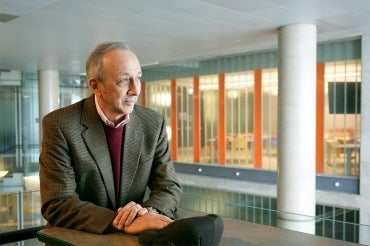U of T Engineering professor aims to reimagine the internet

Professor J.J. Garcia-Luna-Aceves aims to forge a smarter, more equitable internet (photo by Matthew Tierney)
Published: November 16, 2023
For J.J. Garcia-Luna-Aceves, the networks that make up the internet – both the physical layer of routers and switches, as well as the protocols and algorithms that distribute data – hold unused intelligence with the potential to foster major advances.
“The internet we are using today was designed 54 years ago. I mean, I wouldn’t drive a 50-year-old car. But that’s what people are doing,” says Garcia-Luna-Aceves, a professor in the University of Toronto's Edward S. Rogers Sr. department of electrical and computer engineering in the Faculty of Applied Science & Engineering. “There have been adjacent technological advancements over the years in radios, machine learning and the like. But the main algorithms used in the internet protocol stack haven’t followed suit.”
Garcia-Luna-Aceves was this week appointed a Canada Excellence Research Chair in Intelligent Digital Infrastructures, a position that will help him explore and tap into the resources that lie “under the hood” of computer networks. Awarded by the Government of Canada, the Canada Excellence Research Chair (CERC) program aims to fund ambitious research projects that help position Canada as a global leader in innovation.
Garcia-Luna-Aceves points to the smartphone’s upward trajectory as a counterexample to that of the internet.
“Your smartphone is intelligent,” he says. “What makes it so? To act intelligently, one needs memory. Endowing network entities with vast amounts of memory capacity would allow us to rethink the routing protocols that are the backbone of the internet.”
Garcia-Luna-Aceves himself is responsible for sections of that backbone. In the late 1980s, he developed an algorithm to handle the fast communication demands of a flying network of missile interceptors. Although the algorithm was never used for that purpose, it was adopted by networking and communications giant Cisco as part of their Enhanced Interior Gateway Routing Protocol (EIGRP), called DUAL, which is still widely used today.
“That technology was great for that time,” says Garcia-Luna-Aceves. “But we need to build routing tables that not only take into account policies, but the characteristics of the use – the content and the service being accessed and the intent for the communication.”
To get there, he says, we need to go back to first principles – which means forgetting the hardware and bandwidth limitations of 50 years ago, and asking ourselves how we would design the internet today.
That means we need to look at whom the technology is enabling and whom it is not.
“Any solution needs to be not only scalable but affordable and deployable in different settings,” he says. “There are areas, communities and industries today that the internet does not reach, where it has potential as a technology enabler – applications in agriculture, in fishery, you name it. And we can only learn about them by talking to those who have been disenfranchised in the past.”
Garcia-Luna-Aceves plans to launch a multidisciplinary research hub, called the Centre of Excellence for Networking Innovation in Toronto, that draws on international researchers and industry partners to further his vision.
“Professor Garcia-Luna-Aceves has his sights on an ambitious and impactful project. Everything in his distinguished career suggests he’s the person for the job,” says Professor Deepa Kundur, chair of the department of electrical and computer engineering. “I enthusiastically congratulate him on his CERC, a well-deserved recognition of his incredible talent.”
“It’s an opportunity like very few others,” says Garcia-Luna-Aceves. “It’s a clean slate to pursue my research. That I can do so in one of the best, most inclusive cities in North America is an added blessing.”



